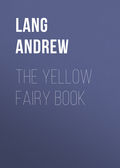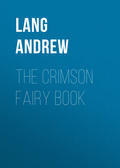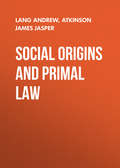
Lang Andrew
The Mystery of Mary Stuart
It will be observed that Crawford’s account of this interview of his with Mary presents some verbal identities with Letter II. And this is notable, for these identities occur where neither Crawford nor the Letter is reporting the speeches on either side. These might easily be remembered, for a while, by both parties. But both parties could not be expected to coincide verbally in phrases descriptive of their meeting, and its details. Thus, Crawford, ‘I made my Lord, my Master’s humble commendations, with the excuse that he came not to meet her.’ In Letter II. we read ‘He made his’ (Lennox’s) ‘commendations, and excuses unto me, that he came not to meet me.’
The excuses, in Crawford, are first of Lennox’s bad health (not in the Letter); next, that he was anxious ‘because of the sharp words that she had spoken of him to Robert Cunningham, his servant,’ &c.
In Letter II. this runs: ‘considering the sharp words that I had spoken to Cunningham.’ Crawford next introduces praises of Lennox which are not in the Letter, but, where a speech is reported, he uses the very words of the Scots translation of Letter II., which vary from the words in the English translation.
It follows that, even here, the Letter, in the Scots version, and Crawford’s Deposition, have one source. Either Crawford took the Scots translation, and (while keeping certain passages) modified it: or the maker of the Letter borrowed from Crawford’s Deposition. In the former case, the sworn corroboration is a perjury: in the latter, the Letter is a forgery.
Crawford has passages which the Letter has not: they are his own reflections. Thus, after reporting Darnley’s remark about the English sailors, with whom he denied that he meant to go away (Letter II. 19), Crawford has, what the Letter has not: ‘And if he had’ (gone away) ‘it had not been without cause, seeing how he was used. For he had neither to sustain himself nor his servants, and needed not make further rehearsal thereof, seeing she knew it as well as he.’ Is this Crawford’s addition or Darnley’s speech? Then there is Crawford’s statement that Mary never stayed more than two hours, at a time, with Darnley – long enough, in an infected room of which the windows were never opened. It is here, after the grumble about Mary’s brief stay, that Crawford adds, ‘She was very pensive, whereat he found fault.’
Now Darnley may have told Crawford (though Crawford does not give this as part of the conversation), ‘I was vexed by the Queen’s moodiness,’ or the like. But it is incredible that Mary herself should also say, in the Letter, just before she mentions going to supper after her first brief interview (Scots) ‘he fand greit fault that I was pensive’ (Letter II. 5[344]). To Mary’s defenders this phrase appears to be borrowed by the forger of the Letter from Crawford’s Deposition; not borrowed by Crawford, out of place and at random (with a skip from Letter II. 5 to Letter II. 19), and then thrust in after his own reflections on the brevity of Mary’s visits to Darnley. For Crawford is saying that her visits were not only short, but sulky. On the other hand, in the Letter the writer is made to contrast Darnley’s blitheness with her gloom.
Crawford does not report, what the Letter makes Mary report, Darnley’s unconcealed knowledge of her relations with Bothwell, at least in the passage, ‘It is thocht, and he belevis it to be trew, that I have not the power of myself unto myself, and that because of the refuse I maid of his offeris.’
Crawford ends with his own reply to Darnley, as to Mary’s probable intentions: ‘I answered I liked it not, because she took him to Craigmillar,’ not to Holyrood. The ‘Book of Articles,’ we know, declares that Mary ‘from Glasgow, be hir letteris and utherwise, held Bothwell continewally in rememberance of the said house,’ that is, Kirk o’ Field. But the Letters produced do nothing of the kind. Craigmillar, as we have seen, is dwelt on. In the Deposition the idea of Darnley’s being carried away as a prisoner is introduced as an original opinion of Crawford’s, expressed privately to Darnley, and necessarily unknown to Mary when she wrote Letter II. But it occurs thus, in Letter II. 9, after mention of a litter which Mary had brought for his conveyance, and to which Darnley, who loved riding of all things, made objection. ‘I trow he belevit that I wald have send him away Presoner’ – a passage not in the English translation. Darnley replied to Crawford’s remark about his being taken as ‘a prisoner’ that ‘he thought little else himself.’ It is reckoned odd that Mary in the Letter makes him ‘think little else himself.’ ‘I trow he belevit that I wald have send him away Presoner.’
For these reasons some German defenders of Mary have decided that the parts of Letter II. which correspond with Crawford’s Deposition must have been borrowed from that Deposition by a forger of the Letter. About June, 1568, Lennox, on this theory, would lend a copy of Crawford’s report (made in January, 1567, at Glasgow) to Wood, and, on returning to Scotland, Wood might have the matter of Crawford’s report worked into Letter II.
I had myself been partly convinced that this was the correct view. But the existence of Mary’s memoranda, and the way in which they influence Letter II., seem to me an almost insuperable proof that part, at least, of Letter II. is genuine. It may, however, be said that the memoranda were genuine, but not compromising, and that the Letter was based, by forgers, on the memoranda (accidentally left lying in her Glasgow room, by Mary) and on Crawford’s report, obtained from Lennox. This is not impossible. But the craft of the forger in making Mary, on her second night of writing, find her forgotten memoranda (II. 15), be reminded by them of her last neglected item (‘Of Monsieur de Levingstoun’), and then go on (II. 16) to tell the anecdote of Livingstone, never publicly contradicted by him, seems superhuman. I scarcely feel able to believe in a forger so clever. Yet I hesitate to infer that Crawford, when asked to corroborate the statements in the Letter, took his report from the Letter itself, and perjured himself when he said, on oath, that his Deposition was derived from a writing taken down from Darnley’s lips ‘immediately at the time.’
I should come to this conclusion with regret and with hesitation. It is disagreeable to feel more or less in doubt as to Crawford’s honour. We know nothing against Crawford’s honour, unless it be that he was cruel to the Hamilton tenantry, and that he deposed to having received confessions on the scaffold, from Bothwell’s accomplices, implicating Mary.[345] These do not occur in the dying confessions printed with Buchanan’s ‘Detection,’ though Bowton hinted something against Mary, when he was in prison; so that trustworthy work informs us. Thus Crawford’s second Deposition, as to the dying confessions, is certainly rather suspicious. We know nothing else against the man. He lived to be a trusted servant of James VI. (but so did the infamous Archibald Douglas); he denounced Lethington of guilt in the murder; he won fame by the capture of Dumbarton Castle. Yet some are led to suspect that, when asked to corroborate a passage in a letter, he simply took the corroboration, textually, from the letter itself. If not the Letter is a forgery.
Mr. Henderson (who does not admit the verbal correspondence of Letter and Deposition) clearly sees no harm in this course. ‘It is by no means improbable that Crawford refreshed his recollection by the aid of the Letter, which, in any case, he may have seen before he prepared his statement.’ But he swore that he wrote a statement, from Darnley’s lips, ‘immediately at the time.’[346] He said nothing about losing the paper, which he wrote in January, 1567. (Mr. Henderson says it ‘had apparently been destroyed’ – why ‘apparently’?) But, according to Mr. Henderson, ‘he may have seen the letter before he prepared his statement. Probably he would have been ready to have admitted this.’ He would have had an evil encounter with any judge to whom he admitted that, being called to corroborate part of a letter, written in French, he copied his corroborating statement, verbally on the whole, from a Scots translation of the letter itself! I do not think that Crawford would have been ‘ready to admit’ this unconscionable villainy. Yet we must either believe that he was guilty of it, or that the Letter was forged.
There is one indication which, for what it is worth, corroborates the truth of Crawford’s oath. He swore that he had written down Darnley’s report of conversations with Mary ‘immediately at the time,’ in order that he, in turn, might report them to Lennox, ‘because the said Earl durst not then, for displeasure of the Queen, come abroad,’ and speak to Darnley himself. But Crawford never swore, or said, that he wrote down his own conversation with Mary. Now, on June 11, 1568, Lennox does not ask for what Crawford swore that he wrote, much the most important part of his evidence, the account of Darnley’s talks with Mary. Lennox does not ask for that, for what Crawford swore that he wrote ‘immediately at the time.’ He merely asks ‘what purpois’ (talk) ‘Thomas Crawford held with the Queen at her coming to the town.’ This may be understood to mean that Lennox already held, and so did not need, Crawford’s written account, dictated by Darnley to him, of the conversations between Mary and Darnley. For that document, if he had it not, Lennox would most certainly ask, but ask he did not. Therefore, it may be argued, Lennox had it all the while in his portfolio, and therefore, again, parts of Letter II. are borrowed from Crawford’s written paper of January, 1567.[347]
In that case, we clear Crawford’s character for probity, but we destroy the authenticity of Letter II.[348] I confess that this last argument, with the fact that we have no evidence against the character of Crawford, a soldier of extraordinary daring and resource, and a country gentleman, not a politician, rather disturbs the balance of probabilities in favour of the theory that he borrowed his Deposition textually from the Letter, and increases the probability that the Letter is a forgery based on the Deposition.[349]
5. The contents of the Letter are said to be incoherent and inconsistent with Mary’s style and character. The last objection is worthless. In the Letter she says that she acts ‘against her natural’ —contre son naturel– out of character. As for incoherence, the items of her memoranda are closely followed in sequence, up to paragraph 8, and the interloping part in paragraph 12. The rest, the work of the second night, is incoherent, as Mary’s moods, if she was guilty, must have been. Information, hatred, remorse, jealousy, and passion are the broken and blended strata of a mind rent by volcanic affections. The results in the Letter are necessarily unlike the style and sentiment of Mary’s authentic letters, except in certain very remarkable features.
Either Mary wrote the Letter or a forger wished to give the impression that this occurred. He wanted the world to believe that the Queen, her conscience tortured and her passion overmastering her conscience, could not cease to converse with her lover while paper served her turn. Her moods alternate: now she is resolved and cruel, now sick with horror, but still, sleepless as she is, she must be writing. Assuredly if this Letter be, in part at least, a forgery, it is a forgery by a master in the science of human nature. We seem to be admitted within the room where alone a light burns through the darkling hours, and to see the tormented Queen who fears her pillow. She writes, ‘I would have almaist had pitie of him… He salutes everybody, yea unto the least, and makes pitious caressing unto them, to make them have pitie on hym,’ a touching picture. There is a pendant to this picture of Darnley, in Buchanan’s ‘History.’ He is speaking of Mary’s studied neglect of Darnley at the time of his son’s christening (December, 1566). Darnley, he says, endured all ‘not only with patience; he was seen trying to propitiate her unjust anger in every way, that humbly, and almost in servile fashion, he might keep some share in her good graces.’[350] What an etching is this of the man, a little while since so haughty and tyrannous, ‘dealing blows where he knew that they would be taken’! Again the passage (Letter II. 11) about Mary’s heart wherein only Bothwell’s ‘shot’ can make a breach, does certainly seem (as Laing notes) to refer to a sonnet of Mary’s favourite poet, Ronsard.
Depuis le jour que la première flèche
De ton bel oëil m’avança la douleur,
Et que sa blanche et sa noire couleur,
Forçant ma force, au cœur me firent brèche.
As in later letters, the writer now shows jealousy of Bothwell’s wife.
The writer again and again recurs to her remorse. ‘Remember how, gyf it were not to obey you, I had rather be deid or I dyd it, my heart bleides at it… Alas, I nevir deceivit anybody; but I remit me altogidder to your will.’ The voice of conscience ‘deepens with the deepening of the night,’ a very natural circumstance showing the almost inhuman art of the supposed forger. What ensues is even more remarkable. Throughout, Mary professes absolute submission to Bothwell; she is here, as Sir John Skelton remarks, ‘the bond slave and humble minister of Bothwell’s ambition.’ He argues that she was really ‘the last woman in the world who would have prostrated herself in abject submission at the feet of a lover.’[351] But, in a later letter to Norfolk, when she regarded herself as affianced to him, Mary says ‘as you please command me, for I will, for all the world, follow your commands…’ She promises, in so many words, ‘humble submission’ – though, conceivably, she may here mean submission to Elizabeth.[352] Again, ‘I will be true and obedient to you, as I have promised.’[353] There are other similar passages in the letters to Norfolk, indicating Mary’s idea of submission to a future husband, an attitude which, according to Randolph, she originally held towards Darnley. These letters to Norfolk, of course, were not dictated by passion. Therefore, under stress of passion or of a passionate caprice, Mary might naturally assume a humility otherwise foreign to her nature. It would be a joy to her to lay herself at her lover’s feet: the argument a priori, from character, is no disproof of the authenticity of this part of the Letter.
On the whole, these reasons are the strongest for thinking the Letter, in parts, probably genuine. The Lords may, conceivably, have added ‘some principal and substantious clauses,’ such as the advice to Bothwell ‘to find out some more secret invention by medicine’ (paragraph 20), and they may have added the words ‘of the ludgeing in Edinburgh’ (Kirk o’ Field) to the dubious list of directions which we find at the end of the Scots, but not in the English, version. There is no other reference to Kirk o’ Field, though the ‘Book of Articles’ says that there were many. And there were many, in the forged letter! Paris, indeed, confessed that Mary told him that Letter II. was to ask where Darnley should be placed, at Craigmillar or Kirk o’ Field. But the evidence of Paris is dubious.
Lennox was very anxious, as was the author of the ‘Book of Articles,’ to prove that the Kirk o’ Field plan was arranged between Bothwell and Mary, before she went to meet Darnley at Glasgow in January, 1567. We have already seen that the ‘Book of Articles’ makes Mary and Bothwell ‘devise’ this house ‘before she raid to Glasgow,’ and ‘from Glasgow by her letters and otherwise she held him continually in remembrance of the said house.’
The ‘Book of Articles’ also declares that she ‘wrote to Bothwell to see if he might find out a more secret way by medicine to cut him off’ than the Kirk o’ Field plan. Now this phrase, ‘a more secret invention by medicine,’ occurs in Letter II. 20, but is instantly followed by ‘for he should take medicine and the bath at Craigmillar:’ not a word of the house in Edinburgh.
Next, we find Lennox, like the author of the ‘Book of Articles,’ hankering after, and insisting on, a mention of the ‘house in Edinburgh’ in Mary’s Letters. There exists an indictment by Lennox in Scots, no doubt intended to be, as it partly was, later done into English. The piece describes Moray as present with the English Commissioners, doubtless at York, in October, 1568. This indictment in Scots is by one who has seen Letter II., or parts of it, for we read ‘Of quhilk purpos reported to Heigat she makes mention in hir lettre sent to Boithuile from Glasgow, meaning sen that purpose’ (the plan of arresting Darnley) ‘wes reveled that he suld invent a mare secrete way be medecine to cutt him of’ (the very phrase used in the ‘Book of Articles’) ‘as alsua puttes the said Boithuil in mynde of the house in Edinburgh, divisit betwix thame for the King hir husband’s distructioune, termand thair ungodlie conspiracy “thair affaire.”’
Now Mary, in Letter II., does not ‘put Bothwell in mind of the house in Edinburgh,’ nor does she here use the expression ‘their affair,’ though in Letter III. she says ‘your affair.’ In Buchanan’s mind (if he was, as I feel convinced, the author of the ‘Book of Articles’) the forged letter described by Moray and Lennox, with its insistence on Kirk o’ Field, was confused with Letter II., in which there is nothing of the sort. The same confusion pervades Lennox’s indictment in Scots, perhaps followed by Buchanan. When parts of the Scots indictment are translated into Lennox’s last extant English indictment, we no longer hear that Kirk o’ Field is mentioned in the Letters, but we do read of ‘such a house in Edinburgh as she had prepared for him to finish his days in’ – which Mary had not done when she wrote Letter II. Consequently the memorandum at the end of Letter II., ‘remember zow of the ludgeing in Edinburgh,’ a memorandum not in the English translation, may have been added fraudulently to prove the point that Kirk o’ Field was, from the first, devised for Darnley’s destruction.[354] These passages, in any case, prove that the false letter reported by Moray and Lennox haunted the minds of Lennox and Buchanan to the last.
The evidence of Nelson, Darnley’s servant,[355] later with Lady Lennox, to the effect that Craigmillar was proposed, but that Darnley rejected it, may be taken either as corroboration of the intention to lodge Darnley at Craigmillar (as is insisted on in Letters I. and II.) or as one of the sources whence Letter II. was fraudulently composed. On the whole, however, the Craigmillar references in the Letters have an air of authenticity. They were not what the accusers wanted; they wanted references to Kirk o’ Field, and these they amply provided in the Letter about poisoning Lady Bothwell, echoes of which are heard in the ‘Book of Articles,’ and in Lennox’s indictment in Scots.
The letter described by Moray and Lennox, when both, at different dates, were in contact with Wood, was full of references to Kirk o’ Field, which are wholly absent in Letters I. and II. The letter known to Moray and Lennox was probably forged in the interval between June 21 and July 8, 1567, when (July 8) the Lords sent ‘Jhone a Forret’ to Moray. As I shall make it evident that Robert Melville was sent to inform Elizabeth about the capture of the Casket on the very day of the event, the pause of seventeen days before the sending of ‘Jhone a Forret’ to Moray is very curious. In that time the letter noticed by Moray and Lennox may have been forged to improve the evidence against Mary. At all events its details were orally circulated. But I think that, finding this letter inconsistent, and overcharged, the Lords, in December, 1568, fell back on the authentic, or partially authentic, Letter II., and produced that. My scheme of dates for that Letter need not necessarily be accepted. My theory that Mary made a mistake as to her sheets of paper which caused the confusion of the internal chronology is but a conjecture, and the objection to it I have stated. The question is one of the most delicately balanced probabilities. Either Lennox, from January 1567 onwards, possessed the notes which Crawford swore that he wrote concerning Darnley’s conversation (in which case much of Letter II. is a forgery based on Crawford), or Crawford, in December 1568, deliberately perjured himself. The middle course involves the unlikely hypothesis that Crawford did take notes ‘immediately at the time;’ but that they were lost or destroyed; and that he, with dishonest stupidity, copied his deposition from Letter II. There appears to me to be no hint of the loss or disappearance of the only notes which Crawford swore that he made. Consequently, on either alternative, the conduct of the prosecutors is dishonest. Dishonesty is again suggested by the mysterious letter which Moray and Lennox cite, and which colours both Lennox’s MS. discourses and the ‘Book of Articles.’ But, on the other hand, parts of Letter II. seem beyond the power of the Genius of Forgery to produce. Perhaps the least difficult theory is that Letter II. is in part authentic, in part garbled.[356]






